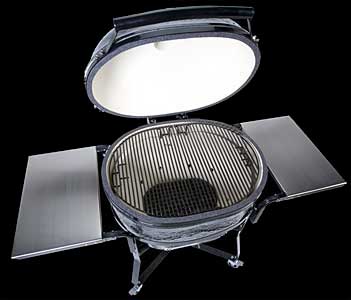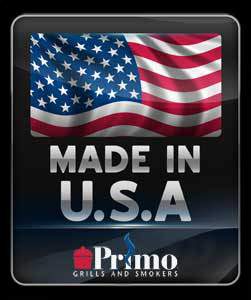|
The Primo Story
 Somewhere around 3,000 years ago, the Chinese invented the kamado cooker. Made of fire clay, these domed, charcoal-fired cookers
made it easy to create moist, flavorful dishes while cooking at a wide range of temperatures, adjusted by controlling the airflow through the
charcoal via manipulation of the clay cap. Somewhere around 3,000 years ago, the Chinese invented the kamado cooker. Made of fire clay, these domed, charcoal-fired cookers
made it easy to create moist, flavorful dishes while cooking at a wide range of temperatures, adjusted by controlling the airflow through the
charcoal via manipulation of the clay cap.
About 2000 years later, the Japanese adopted the "mushi-kamado", and charcoal cooking rapidly became a mainstay of Japanese cuisine.
Enamored with the simplicity of operation, versatility and gourmet results produced by these kamado cookers, American GIs brought them
back from Japan after WWII, and a brisk import business was born.
But there was trouble in paradise: fire clay is a relatively fragile material, and many kamados were lost to breakage. And even the ones that
made it to the patio unscathed would easily break from thermal shock if fired on cold or rainy days. And, there was worse news: fire clay can
only withstand being heated and cooled so many times, so even if they managed to survive the impacts and temperature fluctuations of normal
use, the imported kamados would eventually crumble away.
The kamado had established itself across many cultures over many centuries as an amazingly simple way to cook a variety of foods at a variety
of temperatures, while retaining moisture and improving flavor with accents of charcoal and wood. What was needed was a more durable
material!
And, sure enough, a better material came along. Thanks to NASA research, a recipe for a highly insulating, super-strong ceramic material that
would not break from thermal shock entered the public domain, and the modern ceramic charcoal cooker was born.
 |
 |
| Enter the Good Folks at Primo. What would happen, they wondered, if a kamado
made of the new space-aged ceramics could be fashioned in an oval shape? The
elongated cooking grid would not only be easier to reach across, but would lend
itself better for cooking foods like spareribs or whole fish. And what if there was an optional cast iron firebox divider, so the fire could be
built on one side only for small gatherings, or to offer indirect cooking on the
other side of the oval-shaped cooking grid above? Substitute wood for some or
all of the charcoal, and you'd have a true smoker!
The rest, as they say, is history.
The now-famous Primo Oval ceramic cooker is available in three sizes, the Oval
XL,
Oval LG and Oval Jr. And for the traditionalists, Primo also offers a round model, the
Primo Kamado. All models are backed by
Primo's 20 year warranty.
|
|





